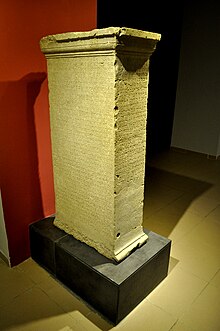türkçe links to original Turkish article
(Milliyet Newspaper, 22 June 2020)

Letoon Trilingual in Fethiye Museum.
letoon trilingual click here for Wikipedia page.
According to Akdeniz University's Prof. Dr. Fatih Onur, the Letoon
inscription that dates from 150-160 B.C. and which mentions the
antique Masa Dağı (Masa Mountain), was discovered in 1993 (sic,
1973, per Wikipedia). The inscription relates that 2,300 years ago
colonists migrated from Great Termessos, a Lycian city in Antalya,
to Oinoanda in Seydikemer, Muğla, and occupied Masa Dağı,
which belonged to Lycia's ancient Tlos city and sits at an altitude of
2,440 meters.
Because of the occupation, a clash erupted between the colonists
and the Lycians. The dispute was brought to a court on Kos Island,
off present-day Bodrum, and the Lycian Union took the case to
the Roman Senate, as well.
In the end, the legal decision gave the resources of Masa Dağı to
Tlos and the colonists who had come from Termessos were restricted
to using the mountain's wood and grazing area and prohibited from
engaging in agriculture and construction. The Lycians were ordered
by the Kos court to pay the colonists 25 talent Rhodes silver as
compensation.

The location of Masa Dağı has finally been established by Prof. Onur
and his team as being today's Hacıosman Mountain in Seydikemer,
Muğla. Prof. Onur explained that "Masa Dağı had strategic importance
for Lycia because it formed its northern border. In addition, a pact
between Julius Caesar and Lycia in 46 B.C. shows Masa Dağı within
Lycia's northern border area. Today, while it is less important than in
ancient times, the mountain's pastures, grazing areas and timber are
still noteworthy. We are continuing our research with Prof. Dr.
Mustafa Ertürk of Akdeniz University in Antalya."
With regard to how he and his team established Masa Dağı's location,
Prof. Onur said that "On the Letoon inscription there are 18 border
markers depicted and Masa Dağı's area is comprehensively explained.
Nevertheless, since the inscription was discovered in 1993, the
mountain's exact location had not been determined. In 2019, after a
detailed mapping effort, we went to the site and fixed the locations of
the valleys and streams mentioned in the inscription."
"One of the streams mentioned in the Letoon inscription was
'Golbanounda', which we identified as today's Hacıosman stream
southeast of Bakıköy in Seydikemir district, and the other was
'Endyrenos', which is today's Sarısu stream south of the Gökbel pasture.
After also identifying the valleys, passes and pasture mentioned in the
inscription, we determined that Masa Dağı is today's Hacıosman Dağı."

Xanthos is at lower left, Termessos at upper right. Masa Dağı
(Hacıosman Dağı) is directly north of Xanthos, between Tlos
and Oenoanda, near Bakırköy.

"... was discovered in 1993 (sic,
YanıtlaSil1973, per Wikipedia)"
The inscription mentioning Mount Masa is a different inscription from Letoon, not the trilingual one (in the photo).